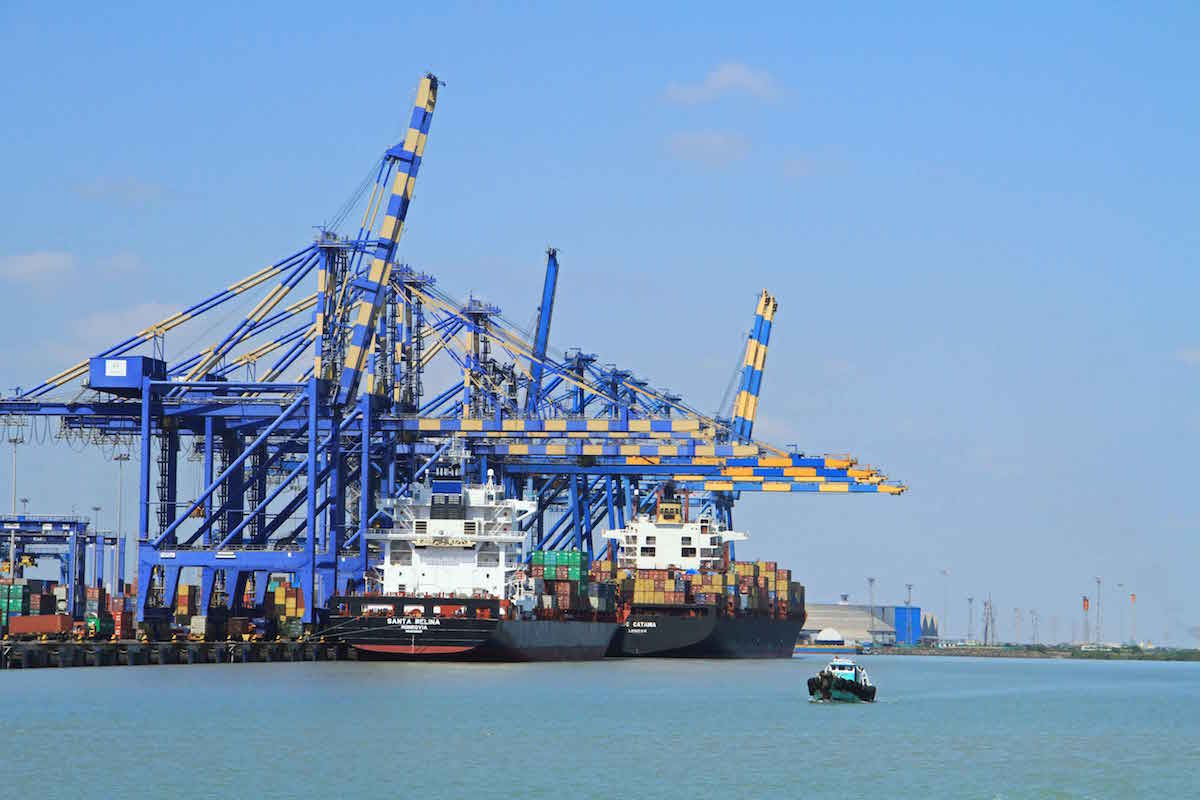Mundra Port. Photo credit: Adnai Ports
By Dhwani Pandya
(Bloomberg) — Gifted with a 4,700-mile coastline, India for years has wanted a world class shipping hub that could compete with regional star Singapore. When the time came this month to help make that dream a reality, policy makers may have botched it up, analysts say.
In the works for at least a decade, the shipping ministry’s long-awaited rules announced in a March 7 notification impose conditions that will end up hindering the growth of Indian ports, according Geneva-based Mediterranean Shipping Co. and Mumbai’s Mantrana Maritime Advisory Pvt.
“The policy gives mixed and confusing signals,” said Deepak Tewari, chief executive officer of Mediterranean Shipping’s India operations. “It won’t help make Indian ports transshipment hubs as most of them, both major and private, won’t be able to meet the conditions laid out to them.”
The half-hearted attempt highlights the conflict between India’s undying love for protectionism and a hesitant wish to overhaul onerous laws that stifle competition and efficiency needed to emulate, say, Singapore. The changes do little to realize the vision of Prime Minister Narendra Modi, who wants to boost trade with better ports and ease congestion on road and rail networks, according to Anand Sharma, a director at Mantrana.
Rajive Kumar, the top bureaucrat at the shipping ministry, didn’t respond to an e-mail seeking comment.
The old rules, in force since 1958, barred foreign ships from carrying cargo from one Indian port to another unless a local vessel was unavailable.
The recent easing allows overseas operators to ferry exported and imported goods, but limits it to ports that transship at least 50 percent of container volume. That still leaves the curbs unchanged for the remaining 88 percent of India’s total traffic: oil, bulk and project cargo, break bulk steel and cars.
“If you want to encourage coastal shipping and foreign players to come in, they should be able to move any and all cargo to and from ports, which I think will boost trade on the coast,” said Vivek Anand, president of the Mumbai Nhava-Sheva Ship Agents Association. “While this is a step in the right direction, it is a piecemeal solution,” he said, adding this may just be a start.
Furthermore, ports that apply for the rule relaxation will need to show a growth of at least 50 percent in cargo transshipment in the first year to retain that benefit, while newer facilities have two years to meet this condition. Should they fail, they lose the benefit for the following three years, according to the notification.
Hardly Comforting
While ports such as Mundra on India’s west coast, operated by Adani Ports & Special Economic Zone Ltd., have been slowly getting more transshipment business, the government’s condition to raise throughput by 50 percent may be impossible to meet, said Nitin Arora, a research analyst at Mumbai-based brokerage Emkay Global Financial Services Ltd.
For instance, Mundra will need to raise its container throughput to 4.35 million TEUs (Twenty Feet Equivalent Units) within a year from its current 2.9 million TEUs, to qualify for the relaxation. Adani Ports shares have declined 21 percent in the past year, compared with a 10 percent loss in the benchmark S&P BSE Sensex.
Such a stipulation isn’t comforting for Chinta Sasidhar, managing director of Krishnapatnam Port Co., a deepwater facility on India’s eastern coast that has struggled to attract big liners since completing its first phase in 2008.
“A longer window could have been more effective in achieving the objective,” he said, adding his port is “well positioned” to commence transshipment.
The new policy hasn’t pleased local operators either. With costs as much as 40 percent higher for Indian vessels at local ports because of numerous taxes, foreign flags have an advantage, said Anil Devli, chief executive officer of the Indian National Shipowners’ Association.
“It is not going to help anyone — neither Indian ships nor foreign,” said Mantrana’s Sharma. “The status remains the same as earlier.”
In a nation already crippled by infrastructure constraints, inadequate berths and road links have meant reluctant foreign shipping lines balking at the prospect of an average turnaround time of four to five days at various Indian ports, compared with about eight hours in Shanghai.
On top of these bottlenecks, a restrictive policy only adds to the cost of outbound and inbound shipments, deterring economic growth, said Franck Dedenis, managing director at Maersk Line India Pvt. in Mumbai.
Ships handled 68 percent of India’s $786.2 billion trade in 2014, according to latest government data compiled by Bloomberg. The country has 12 major and 187 non-major ports, with cargo traffic recorded at 1,052 million metric tons in 2015, according to the shipping ministry. That compares with 576 million tons for Singapore alone.
“It is certainly advantageous to have such laws when the local shipping industry is robust and also has adequate capacity,” he said in an e-mail response to a query before the notification came out. “Unfortunately, this is not so in India.”
(An earlier version of the story corrected the headquarters of Mediterranean Shipping Co. to Geneva in the second paragraph.)
–With assistance from Kyunghee Park, Bibhudatta Pradhan, Anurag Kotoky and Unni Krishnan.
© 2016 Bloomberg L.P
Unlock Exclusive Insights Today!
Join the gCaptain Club for curated content, insider opinions, and vibrant community discussions.

 Join The Club
Join The Club







![A screengrab of a map showing an earthquake Mindanao, Philippines on Dec 2, 2023. (Image: US Geological Survey [USGS])](https://gcaptain.com/wp-content/uploads/2023/12/Screenshot-2023-12-02-at-10.45.17-AM-copy.png.webp)





